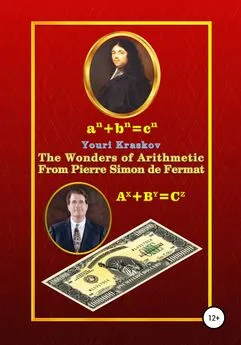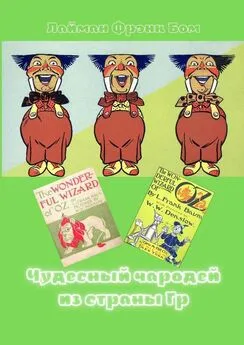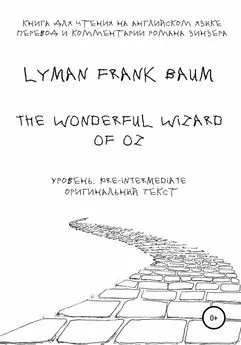Youri Kraskov - The Wonders of Arithmetic from Pierre Simon de Fermat
- Название:The Wonders of Arithmetic from Pierre Simon de Fermat
- Автор:
- Жанр:
- Издательство:неизвестно
- Год:2021
- ISBN:978-5-532-98629-9
- Рейтинг:
- Избранное:Добавить в избранное
-
Отзывы:
-
Ваша оценка:
Youri Kraskov - The Wonders of Arithmetic from Pierre Simon de Fermat краткое содержание
The Wonders of Arithmetic from Pierre Simon de Fermat - читать онлайн бесплатно ознакомительный отрывок
Интервал:
Закладка:
Here we come to the fact that the main reason for failures in the search for FLT proof lies in the difference between approaches to solving tasks by Fermat and other scientists, as well as in the fact that even modern science has not reached the knowledge that already was used by Fermat in those far times. This situation needs to be corrected because otherwise the FLT so will continue to discredit whole science.
One of the main questions in the studies on the FLT was the question of what method did Fermat use to prove this theorem? Opinions were very different and most often it was assumed that this was the method of descent, but then Fermat himself hardly called it "truly amazing proof." He also could not apply the Kummer method, from which the best result was obtained in proving the FLT proof over the last 170 years. But perhaps he besides the descent method had also other ones? Yes indeed, this is also described in detail in treatise "A New Discovery in the Art of Analysis" by Jacques de Billy [36]. There, he sets out in detail Fermat's methods, which allow him to find as many solutions as necessary in systems of two, three, or more equations. But here his predecessors Diophantus, Bachet and Viet at best found only one solution. After demonstrating Fermat's methods for solving the double equalities Billy also points to the most important conclusion, which follows from this: This kind of actions serves not only to solve double equalities, but also for any other equations .
Now it remains only to find out how to use the system of two equations to prove the FLT? Obviously, mathematicians simply did not pay attention to such an explicit clue from Fermat or did not understand its meaning. But for us this is not a problem because we can look into the cache and delve into the "heretical writings"! Based on what we have already been able to recover from Fermat’s works, we can now begin to uncover this greatest mystery of science, indicating also an effective method that allows us to solve the problem of FLT proof.
How it wouldn't be surprising, the essence of this method is quite simple. In the case when there are as many equations as there are unknowns in them, such a system is solved by ordinary substitutions. But if there is only one equation with several unknowns, then it can be very difficult to establish whether it can even have any solutions in integers. In this case, the numbers supposed as solutions can be expressed in the form of another equation called the “Key Formula” and then the result can be obtained by solving a system of two equations. Similar techniques when some numbers are expressed through others, have always been used by mathematicians, but the essence of the key formula is in another, it forms exactly that number, which reflects the essence of the problem and this greatly simplifies the way to solving the original equation. In such approaches and methods, based on an understanding the essence of numbers, in fact also lies the main superiority of Fermat over other scientists. 50
To make it possible to follow the path that Fermat once laid, you need to find the starting element from the chain of events leading to the appearance of the FLT, otherwise there will be very little chance of success because everything else is already studied far and wide. And if we ask the question exactly this way, we will suddenly find that this very initial element was still in sight from 1670, but since then no one has paid any attention to it at all. However, in fact, we are talking about the very problem under number 8 from the book II of Arithmetic by Diophantus, to which also Fermat’s remark was written, became later a famous scientific problem. Everyone thought that this simple-looking problem has no difficulties for science and only Fermat had another opinion and worked for many years to solve it. As a result, he not only obtained it, but in addition to this he secured to his name unfading world fame.
4.1.2. Diophantus' Task
The book entitled “Arithmetic” by Diophantus is very old however, probably it appeared not in III as it was thought until recently, but in the XIV or XV century. In those times when yet there were no print editions, it was a very impressive in volume manuscript consisting of 13 books, from which only six ones reached us. In today's printed form this is a small enough book with a volume of just over 300 pages [2, 27].
In France an original Greek version of this book was published in 1621 with a Latin translation and comments from the publisher, which was Bachet de Méziriac. This publication became the basis for Fermat's work on arithmetic. The contents of the book are 189 tasks and solutions are given for all them. Among them are both fairly simple and very difficult tasks. However, since they have been solved, a false impression is created that these tasks are not educational, but rather entertaining ones i.e., they are needed not to shape science, but to test for quick wit. In those times, it could not have been otherwise because even just literate people who could read and write were very rare.
However, from the point of view the scientific significance of the presented tasks and their solutions, the creation of such a book is not something that to the medieval Diophantus, but to all scientists in the entire visible history would be absolutely impossible. Moreover, even at least properly understanding the contents of the Euclid's "Elements" and the Diophantus' "Arithmetic" became an impossible task for our entire science. Then naturally, the question arises how did the authors of these books manage to do such creations? Of course, this question also arose in science, but instead of answering it only retains its proud silence. Well, then nothing prevents us from expressing our version here.
Apparently, there were somehow preserved and then restored written sources of knowledge from a highly developed civilization perished in earlier times. Only especially gifted people with extrasensory abilities allowing them to understand written sources regardless of the carrier and language, in which they were presented, could read and restore them. Euclid who was most likely a king, involved a whole team of such people, while Diophantus coped itself one and so the authorship of both appeared although in fact it was not the scientists who worked on the books, but only scribes and translators. But now we come back to the very task 8 from the second book of “Arithmetic” by Diophantus: Decompose a given square into the sum of two squares .
In the example of Diophantus, the number 16 is divided into the sum of two squares and his method gives one of the solutions 4 2=20 2/5 2=16 2/5 2+12 2/5 2as well as countless other similar solutions 51. However, this is not a solution to the task, but just a proof that any integer square can be made up of two squares any number of times either in integer or in fractional rational numbers. It follows that the practical value of the Diophantus method is paltry since from the point of view of arithmetic, the fractional squares are nonsense like, say, triangular rectangles or something like that. Obviously, this task should be solved only in integers, but Diophantus does not have such a solution and of course, Fermat seeks to solve this problem himself especially since at first, he sees it as not at all complicated.
So, let in the equation a 2+b 2=c 2given the number c and you need to find the numbers a and b . The easiest way to find a solution is by decomposing the number c into prime factors: c=pp 1p 2…p k; then
c 2=p 2p 1 2p 2 2…p k 2=p 2(p 1p 2…p k) 2=p i 2N 2
Now it becomes obvious that the number c 2can be decomposed into a 2+ b 2only if at least one of the numbers p i 2also decomposes into the sum of two squares. 52But this is a vicious circle because again you need to decompose square into a sum of two squares. However, the situation is already completely different because now you need to decompose a square of prime number and this circumstance becomes the basis for solving the task. If a solution is possible, then there must exist such prime numbers that decomposes into the sum of two squares and only in this case in accordance with the identity of the Pythagoreans, you can obtain:
p i 2=(x 2+y 2) 2=(x 2−y 2) 2+(2xy) 2
i.e. the square of such a prime will also be the sum of two squares. From here appears the truly grandiose scientific discovery of Fermat: 53
All primes of type 4n+1 can be uniquely decomposed into the sum of two squares, i.e. the equation p=4n+1=x 2+y 2has a unique solution in integers. But all other primes of type 4n−1 cannot be decomposed in the same way.
In the Fermat's letter-testament it was shows how this can be proven by the descent method. However, Fermat’s proof was not preserved and Euler who solved this problem had to use for this all his intellectual power for whole seven years. 54Now already the solution to the Diophantine task seems obvious. If among the prime factors of number c there is not one related to the type 4n+1, then the number c 2cannot be decomposed into the sum of two squares. And if there is at least one such number p i, then through the Pythagoreans’ identity it can be obtain:
c 2= N 2p i 2= (Nx) 2+(Ny) 2
where x= u 2−v 2; y=2uv; a=N(u 2−v 2); b=N2uv
The solution is obtained, however it clearly does not satisfy Fermat because in order to calculate the number N you need to decompose the number c into prime factors, but this task at all times was considered as one of the most difficult of all problems in arithmetic. 55Then you need to calculate the numbers x, y i.e. solve the problem of decomposing a prime of type 4n+1 into the sum of two squares. To solve this problem, Fermat worked almost until the end of his life.
It is quite natural that when there is a desire to simplify the solution of the Diophantine task, a new idea also arises of obtaining a general solution of the Pythagoras’ equation a 2+ b 2= c 2in a way different from using the identity of Pythagoreans. As it often happens, a new idea suddenly arises after experienced strong shocks. Apparently, this happened during the plague epidemic of 1652 when Fermat managed to survive only by some miracle, but it was after that when he quite clearly imagined how to solve the Pythagoras’ equation in a new way.
However, the method of the key formula for Fermat was not new, but when he deduced this formula and immediately received a new solution to the Pythagoras equation, he was so struck by this that he could not for a long time come to oneself. Indeed, before that to obtain one solution, two integers must be given in the Pythagoreans' identity, but with the new method, it may be obtained minimum three solutions with by only one given integer.
But the most surprising here is that the application of this new method does not depend on the power index and it can be used to solve equations with higher powers i.e. along with the equation a 2+b 2=c 2can be solved in the same way also a n+b n=c nwith any powers n>2. To get the final result, it remained to overcome only some of the technical difficulties that Fermat successfully dealt with. And here such a way it appeared and became famous his remark to the task 8 of Book II Diophantus' "Arithmetic":
Cubum autem in duos cubos, aut quadrato-quadratum in duos quadrato-quadratos, et generaliter nullam in infinitum ultra quadratum potestatem in duas eiusdem nominis fas est dividere cuius rei demonstrationem mirabilem sane detexi. Hanc marginis exiguitas non caperet .
Читать дальшеИнтервал:
Закладка:



![О Генри - С высоты козел [From the Cabby's Seat]](/books/1083418/o-genri-s-vysoty-kozel-from-the-cabby-s-seat.webp)






